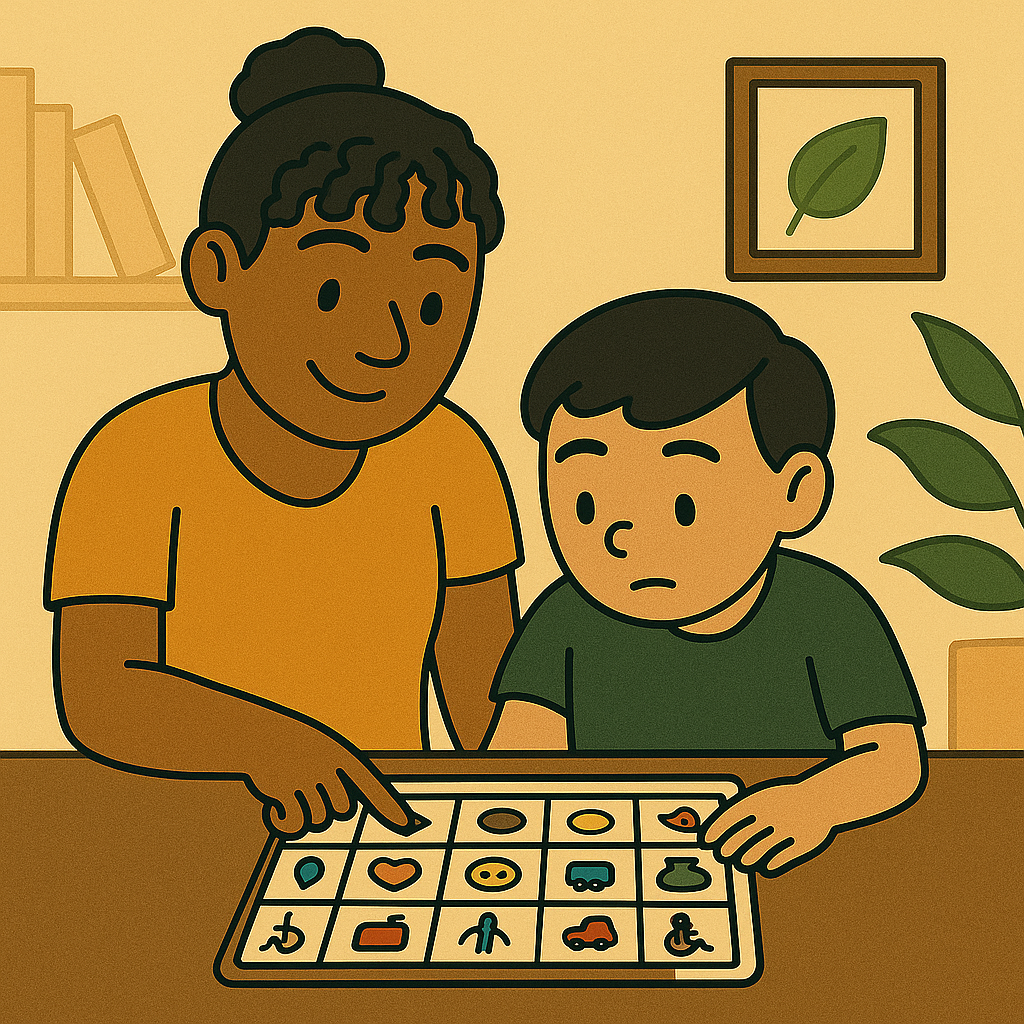6-minute read
Imagine Not Being Able to Speak…
Imagine you’re in a hospital bed after a stroke, your thoughts racing—but your mouth can’t form the words. Or you’re a young child with autism, frustrated every day because you can’t express your wants, needs, or emotions. How would you ask for help, say “I’m in pain,” or tell someone “I love you”?
That’s the daily reality for millions of individuals with communication challenges.
Thankfully, AAC—Augmentative and Alternative Communication—bridges that gap.
Whether through a high-tech tablet or a simple picture board, AAC empowers people to be heard, understood, and included. If you’re a therapist, caregiver, or educator, understanding AAC is key to transforming lives.
👉 Want practical AAC tools and cheat sheets?
Subscribe to get free Quick Reference Sheets for OT, PT, and ST—plus sneak peeks of our therapy Pocket Guides.
As an Amazon Associate, I earn from qualifying purchases. This means if you click on a product link and make a purchase, I may receive a small commission at no extra cost to you. I only recommend tools I trust and use to support AAC and therapy practices.
What Exactly Is AAC Communication?
AAC stands for Augmentative and Alternative Communication—a broad term describing all forms of communication (other than verbal speech) used to express thoughts, needs, and ideas.
AAC can be:
- Augmentative: Adding to someone’s existing speech
- Alternative: Replacing speech when none is available
It helps:
- Children and adults with autism, cerebral palsy, Down syndrome
- People with ALS, stroke, traumatic brain injury
- Anyone with temporary or permanent speech limitations
Communication is a human right. AAC helps ensure no one is left voiceless.
📚 External Resource: ASHA – What Is AAC?
Types of AAC: From Picture Boards to Eye Gaze Devices

AAC tools vary widely depending on the individual’s needs.
✅ No-Tech AAC
- Gestures
- Sign language
- Facial expressions
- Drawing or writing
✅ Low-Tech AAC
- PECS books
- Velcro-backed symbol boards (Buy Velcro dots)
- Laminated picture cards (or grab a Laminator on Amazon)
✅ Mid-Tech AAC
- Simple voice recorders
- Switch-access devices, such as:
- Button switches
- Sip-and-puff switches (activated by inhaling or exhaling air)
- Eye blink switches
- Proximity switches (triggered by movement near the device)
- Head or foot switches
✅ High-Tech AAC
- iPads with AAC apps installed (don’t forget the Kid-proof iPad case)
- Speech apps like Proloquo2Go, LAMP
- Mouth stylus or switch systems
- Tablet mounts for wheelchairs
How AAC Changes Lives

AAC can be transformative:
- ✅ Increases independence
- ✅ Builds confidence
- ✅ Supports academic success
- ✅ Encourages social connection
- ✅ Allows for self-advocacy
From toddlers learning their first words to adults reclaiming their voice after injury or illness, AAC empowers people to fully participate in their lives.
📚 External Resource: Communication Matters – Benefits of AAC
Common Myths About AAC

Let’s bust some of the most common misconceptions:
🛑 “AAC will stop someone from learning to talk.”
✅ Research shows AAC often supports speech development.
🛑 “AAC is only for nonverbal people.”
✅ Many AAC users have limited, unclear, or inconsistent speech.
🛑 “AAC is too expensive or hard to learn.”
✅ There are free apps, school supports, and customizable tools at all levels.
AAC should never be a last resort—it should be a first step toward communication.
The Role of the SLP (and the Whole Team!)

SLPs are at the heart of AAC support:
- 🔍 Evaluate communication abilities
- 🔧 Trial different tools and systems
- 📚 Train caregivers, clients, and educators
- 🤝 Collaborate with:
- Occupational Therapists (for motor and sensory access)
- Physical Therapists (for positioning and mobility)
- Teachers and parents (for carryover at home and school)
Helpful tools:
Choosing the Right AAC System

There is no one-size-fits-all solution. Factors to consider:
- Fine motor and visual abilities
- Cognitive level
- Preferences and motivation
- Access method (e.g., direct touch, switch scanning, eye gaze)
- Portability and durability
💸 Funding options:
- Insurance
- Medicaid/Medicare
- School districts (IEPs)
- Grants and donations
📚 External Resource: Funding AAC Devices – PrAACtical AAC
Every Voice Matters: Let’s Keep Talking About AAC

AAC isn’t just a clinical tool—it’s a life-changing pathway to freedom, connection, and confidence.
Whether you’re working with a preschooler developing early language or an adult recovering from a stroke, AAC gives people the chance to be heard—and that’s everything.
💡 Want More AAC Tools at Your Fingertips?

Subscribe now to get:
- 🧠 Free Quick Reference Sheets for OT, PT, and ST
- 📘 Previews of our therapy Pocket Guides
- 💌 Tips and product ideas delivered to your inbox!
- OT Pocket Guide – Out now (ebook + paperback)
- ST Pocket Guide – Releasing this month
- PT Pocket Guide – Coming in October
💬 We Want to Hear From You

Have you ever worked with or cared for someone who used AAC?
What tool, tip, or breakthrough made the biggest difference?
👇 Share your story in the comments—we learn best when we learn together.

Leave a Reply